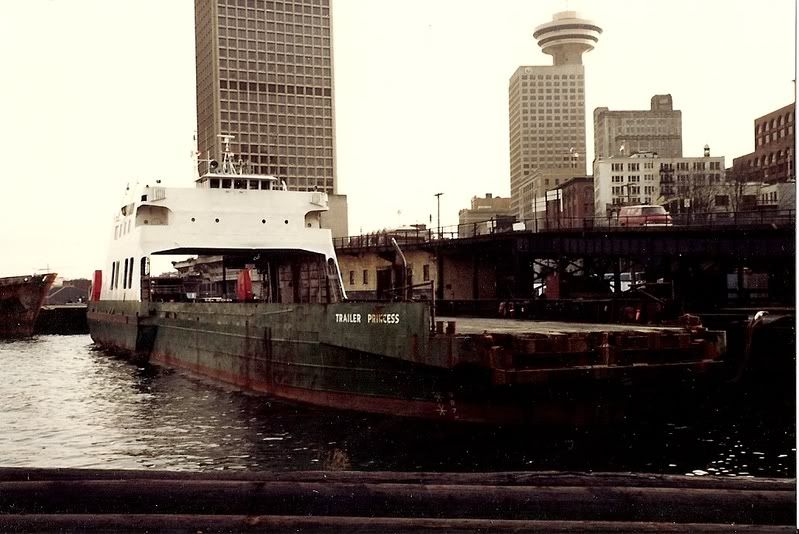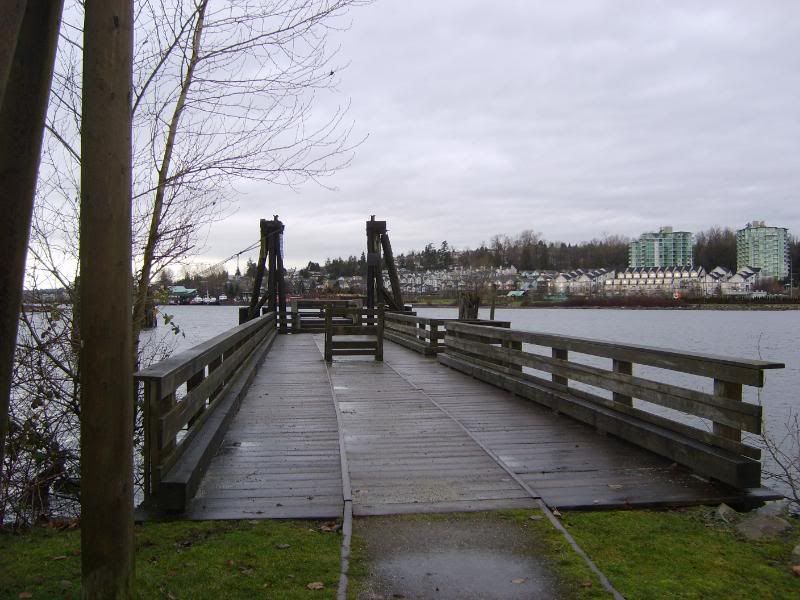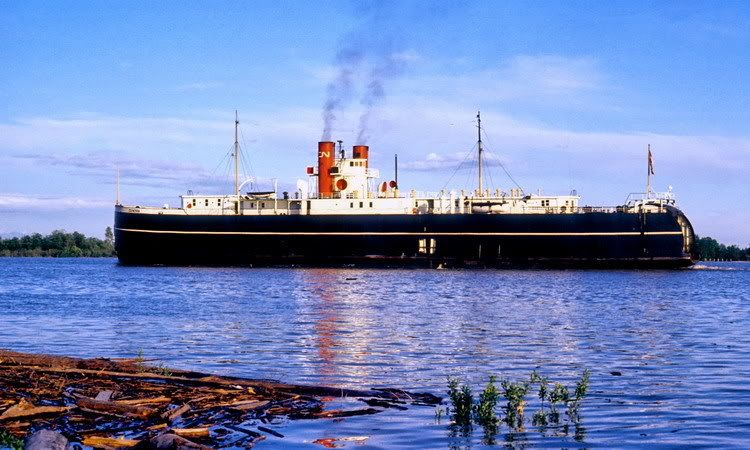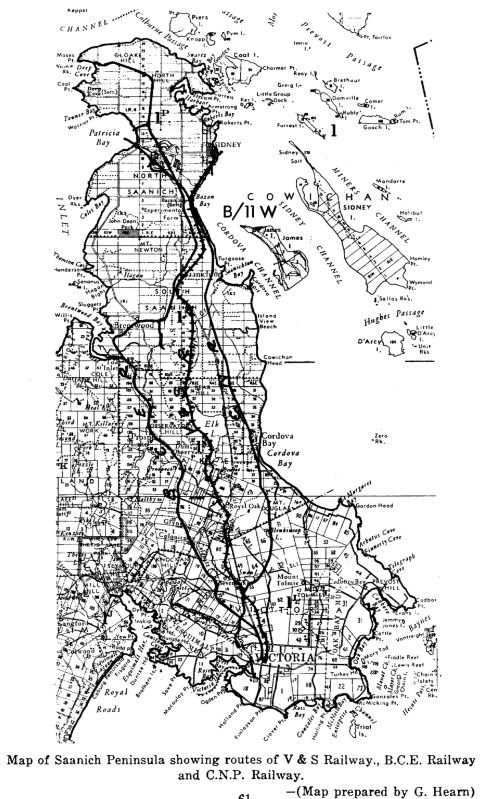Post by Retrovision on Feb 11, 2008 21:54:00 GMT -8
I've noticed the topic of commercial traffic popping up OT lately in atleast a couple threads, so thought - especially considering its importance to the history of coastal shipping of B.C. - I'd start this specific thread in the most appropriate category/board.
To start, I've gathered recent posting on the subject and posted them here...
Well, I guess if the Spirits can be historic, so can the Trailer Princess. At least it's old and gone.
Built 1944 for the U.S. Navy, rebuilt for CP in 1966.
From the Vancouver Sun, Jan. 25, 1986....
Ferry move cuts 19 jobs
CP Rail is scrapping its trailer ferry Trailer Princess, throwing 19 men out of work, the company confirmed Friday.
Crew members aboard the vessel met Friday with Ed Moule, CP Rail's director of coastal marine operations, who told them the vessel's operating certificate would not be renewed after it expires in June.
CP Rail spokesman Don Bower confirmed in a telephone interview that the 42 year old vessel, a former U.S. Navy landing craft that was converted to carry rail cars and drop trailers in 1966, will be scrapped.
"It's worn out," he added. "It's come to the end of its useful economic life."
Bower said the Trailer Princess, which has a capacity of 28 drop trailers, has not carried rail cars for several years.
He said taking it out of commission will not affect CP Rail's nightly rail car and trailer service to Vancouver Island from downtown Vancouver.

From "The Princess Story - A Century and a Half of West Coast Shipping" (Published 1974) by Norman R. Hacking and W. Kaye Lamb, starting on Page 319...
And starting on Page 328, showing how historic the foot in the door of Intermodal ferrying the Trailer Princess was for the C.P.R....
From the Vancouver Sun, Jan. 25, 1986....
Ferry move cuts 19 jobs
CP Rail is scrapping its trailer ferry Trailer Princess, throwing 19 men out of work, the company confirmed Friday.
Crew members aboard the vessel met Friday with Ed Moule, CP Rail's director of coastal marine operations, who told them the vessel's operating certificate would not be renewed after it expires in June.
CP Rail spokesman Don Bower confirmed in a telephone interview that the 42 year old vessel, a former U.S. Navy landing craft that was converted to carry rail cars and drop trailers in 1966, will be scrapped.
"It's worn out," he added. "It's come to the end of its useful economic life."
Bower said the Trailer Princess, which has a capacity of 28 drop trailers, has not carried rail cars for several years.
He said taking it out of commission will not affect CP Rail's nightly rail car and trailer service to Vancouver Island from downtown Vancouver.
postscript: Although this 1986 article said the Trailer Princess was to be scrapped, I see she is still on the Transport Canada Registry, owned by Helifor Canada, a helicopter logging and heavy lift company. Their website has a number of videos, but the 'Princess isn't in them.
...

This dock is attached to a little park along River Road in Richmond, between No. 6 and No. 7 Roads. Obviously, at one time it served rail barges/ferries- I'm wondering who? It's a CN line, I believe, but would it have been their vessels?
I believe that this used to be one of the older rail bridges that ran across the Fraser. There are still a few remnants of some of these kicking around -- you can see some of them better (on a clear day and when there is not so much marine traffic) from along the waterfront on the New Westminster side, looking towards Richmond.

This dock is attached to a little park along River Road in Richmond, between No. 6 and No. 7 Roads. Obviously, at one time it served rail barges/ferries- I'm wondering who? It's a CN line, I believe, but would it have been their vessels?
It was a CN barge slip. That was CN's connection with it's railway on Vancouver Island(now the Galloping Goose and Trans-Canada Trail). CN had 3 barge slips on the Lower Mainland, one at Port Mann(Thornton yard), the one at Mile 8 on the Lulu Island branch and another at Tilbury. CP Rail bought the barge slip at Tilbury from CN for their Coastal Intermodal barges so they could abandon their barge slip on the Vancouver Watefront. The Tilbury barge slip is used by Seaspan now who bought Coastal Intermodal from CP, and access to the E&N is via Tilbury.
CN at one time had 4 barge slips on Vancouver Island. One at Point Ellice, just south of the Bay St. Bridge, one at Ogden Point, and one at Cowichan Bay, as well as a barge slip at Patricia Bay(abandoned 1931).
Here's a photo of the yard crew switching the Seaspan Greg at the Point Ellice barge slip in Victoria. Jason King photo.

The vessels serving the barge slip on Lulu Island depends on the time that CN used the slip. Before 1965 it would have been the Canora. www.bcarchives.gov.bc.ca/cgi-bin/www2i/.visual/img_med/dir_107/b_06784.gif
In later years barge service was contracted to Seaspan. I believe the Seaspan Greg handled the CN traffic to the Island.
CN canceled its contract with Seaspan in 1988, routing all cars through the interchange with the Esquimalt and Nanaimo Railway in Victoria just north of the Johnson Street Bridge.



Dave "Goose5" photos.
For more info on CN on Vancouver Island
www.cowichansubdivision.com/main.html
There has been over 150 years of commercial traffic between the mainland and the Island. I know virtually nothing about it, and it's never been explored on this forum.
I posted a photo of the Canora on this forum about a year and a half ago. See the West Coast Steamships thread, reply #5.
ferriesbc.proboards20.com/index.cgi?board=qa&action=display&thread=1158709271&page=1
It is quite possible that you missed it at the time it was posted. Here is another look...

Last Trip of CN's Canora - Fraser River - 24 May 1967 (DOT collection)
Looking in Norman Hacking's little book, Prince Ships of Northern BC:
In order to provide a link between the company's new Victoria to Patricia Bay line on Vancouver Island and Port Mann, the Canadian Northern ordered the train and passenger ferry 'Canora' from the Davie Shipbuilding and Repair Company of Lauzon, Quebec. She was a vessel of 2383 gross tons, 940 net tons, 308 feet by 52.1 by 18.8, and was launched on June 10, 1918. Powered with a four cylinder, triple expansion engine developing 2,200 i.h.p., she was a double ender with two propellers at each end. She was designed to carry passengers but the accommodation was never completed.
Hacking says she was sold for scrap in 1968, but, at the time of the book (1995), the hull was still afloat somewhere. He says the engines were donated to a Chilliwack museum in 1985.
It seems like the Canora might have been the only actual freight ferry CN operated, among it's tug and barge services, though I'd be happy to learn of others.
I guess it would be appropriate if this little diversion could have been tacked onto a more appropriate thread, but, here it is.[/size]Another interesting thing about the Canora is that CN inherited this from its predecessor company the Canadian Northern Pacific Railway (CNP). The Canadian Northern and the Grand Trunk Pacific (GTP) simultaneously built trackage all over western Canada, competing with each other and with the well established CPR. They also established marine opearations on the BC coast, and ordered vessels for those operations.
During the First World War both new companies (CNP & GTP) fell into bankruptcy. To make a long story short by ~1920 both ended up becoming part of the nationalized Canadian National (CN) system.
CN's marine operations on the BC coast inherited several fine Prince ships from the GTP side. From CNP they inherited the Canora. There may have been some other vessels too. I should do some reading.[/size][/quote]
I was not aware that the GTP ever had plans to build trackage on Vancouver Island. The CNP, on the other hand, did build quite a bit of track, and after nationalization, CN extended trackage north from Victoria to Cowichan Lake. They planned to go from Cowichan Lake to Alberni. Apparently most of the grade was built, but rail was never laid. Some of it did get rails later, but it was logging companies that did this, not CN.
GTP did plan to go head to head with CP for the marine market, especially on what was known as CP's Triangle Service (Vancouver, Victoria, Seattle). They also established a fine service along the coast between Vancouver and the GTP terminal city, Prince Rupert.
Another interesting side note is the Vancouver, Pacific and Great Eastern Railway, that was planned to link Prince George with Vancouver. This is the line known later as the Pacific Great Eastern, and later still, as BC Rail. This was originally planned, in part, to be the GTP's entry into the Vancouver market. It did not quite work out. The PGE was pretty much the 'fast ferries' of that time ninety years ago. It was not until the 1950's that Vancouver was actually connected by rail to Prince George.
CP also had a connection to the Union Pacific Railroad via the Seaspan barge slip near the roundhouse in Victoria.
To start, I've gathered recent posting on the subject and posted them here...
hornbyguy said:
Not historic, not a BC Ferry, not a 'steamship', and, while it was a predecessor to the current Seaspan fleet, it wasn't one of them. So where to post about this minor member of BC's shipping history?Well, I guess if the Spirits can be historic, so can the Trailer Princess. At least it's old and gone.
Built 1944 for the U.S. Navy, rebuilt for CP in 1966.
From the Vancouver Sun, Jan. 25, 1986....
Ferry move cuts 19 jobs
CP Rail is scrapping its trailer ferry Trailer Princess, throwing 19 men out of work, the company confirmed Friday.
Crew members aboard the vessel met Friday with Ed Moule, CP Rail's director of coastal marine operations, who told them the vessel's operating certificate would not be renewed after it expires in June.
CP Rail spokesman Don Bower confirmed in a telephone interview that the 42 year old vessel, a former U.S. Navy landing craft that was converted to carry rail cars and drop trailers in 1966, will be scrapped.
"It's worn out," he added. "It's come to the end of its useful economic life."
Bower said the Trailer Princess, which has a capacity of 28 drop trailers, has not carried rail cars for several years.
He said taking it out of commission will not affect CP Rail's nightly rail car and trailer service to Vancouver Island from downtown Vancouver.

tsawwassenterminal said:
Great angle, Neil, thanks for that. I'd argue that she's quite historic, not just by how long ago the photograph was taken let alone the massively changed landscape today where she's sitting (perpendicular to where the CR's Open House was held and missing numerous landmarks including Canada Place in the background), but more to the point the historical shift in the transportation of intermodal traffic that she represented for the C.P.R., the first of her kind in our waters other than Yorke & Sons pioneering efforts that came very soon before and were were contracted and chartered by the C.P.R. anyways, taking the place of former tug and barge services and, as Harry Tyson - Manager of the B.C. Coast Service until 1973 - predicted with this venture, a successful glimpse at what would be the standard in intermodal transportation to the island through today and the foreseeable future.From "The Princess Story - A Century and a Half of West Coast Shipping" (Published 1974) by Norman R. Hacking and W. Kaye Lamb, starting on Page 319...
From its earliest days the passenger steamers of the Coast Service had een supplemented by barges, towed by tugs, that moved railway cars back and forth between Vancouver Island and the mainland. When the Canadian Pacific took over the C.P.N. the rival Great Northern Railroad, which at the time was making a determined effort to extend its operations in British Columbia, was arranging for such a service. The C.P.R. countered the move by and agreement with the Esquimalt & Nanaimo Railways (at the time still and independent company) to operate car barges between Ladysmith and Vancouver. By a coincidence the same day that Captain Troup became Manager of the Canadian Pacific Navigation Company - March 5, 1901 - the tug Pilot towing the barge Transfer No. 1 moved the first freight cars across the gulf.
Many other tugs and barges followed in their wake during the next half century, including such well-known tugs as the Nanoose, Qualicum and Nitinat. The latter, originally the William Jolliffe of Liverpool, was a handsome craft with two funnels which in her day had been the most powerful salvage tug in the world. In 1957 the Kyuquot, the last Canadian Pacific tug in operation on the Coast, was retired and thereafter C.P.R. car barges were towed under contract, first by the Island Tug & Barge Company and then by F.M. Yorke & Sons.
The design of the Princess of Vancouver, which enabled her to carry railway cars as well as automobiles, trucks and trailers, indicated that the C.P.R. felt that the day of the car barge might be ending, and Tyson brought this about in 1964. That year Yorke & Sons completed the car ferry Greg Yorke (Now Seaspan Intermodal's Seaspan Greg), which began carrying C.P.R. freight cars under charter. A steel, twin-screw motorship 325 feet long, she can best be described as a large self-propelled barge. She could carry 25 railway cars on her four tracks. Four years later she was replaced by the Doris Yorke (Now Seaspan Intermodal's Seaspan Doris), similar in dimensions but fitted with an upper deck that accommodates 26 trailers.
Meanwhile Tyson had decided that it was time the C.P.R. acquired a somewhat similar ship of its own. Looking about for a suitable ship of its own. Looking about for a suitable ship in 1966 he found the U.S.S. Coronis which was purchased, rebuilt and renamed Trailer Princess. A motorship 308 feet long and of 2689 tons gross, she was originally the LST 1033, a tank landing ship built at Baltimore in 1944. Later she was converted into an auxiliary repair ship for landing craft and renamed Coronis. After serving in the Soloman Islands with the tank force that captured Okinawa, and in Japan, she was laid up in Portland. The Canadian Pacific brought her to Victoria, where she was refitted to carry railway cars and also road trailers, which had become an important element in the Company's transportation system. She could carry thirty-two 40-foot trailers and was soon busy ferrying merchandise, much of it perishable goods, between Vancouver and Swartz Bay.
Many other tugs and barges followed in their wake during the next half century, including such well-known tugs as the Nanoose, Qualicum and Nitinat. The latter, originally the William Jolliffe of Liverpool, was a handsome craft with two funnels which in her day had been the most powerful salvage tug in the world. In 1957 the Kyuquot, the last Canadian Pacific tug in operation on the Coast, was retired and thereafter C.P.R. car barges were towed under contract, first by the Island Tug & Barge Company and then by F.M. Yorke & Sons.
The design of the Princess of Vancouver, which enabled her to carry railway cars as well as automobiles, trucks and trailers, indicated that the C.P.R. felt that the day of the car barge might be ending, and Tyson brought this about in 1964. That year Yorke & Sons completed the car ferry Greg Yorke (Now Seaspan Intermodal's Seaspan Greg), which began carrying C.P.R. freight cars under charter. A steel, twin-screw motorship 325 feet long, she can best be described as a large self-propelled barge. She could carry 25 railway cars on her four tracks. Four years later she was replaced by the Doris Yorke (Now Seaspan Intermodal's Seaspan Doris), similar in dimensions but fitted with an upper deck that accommodates 26 trailers.
Meanwhile Tyson had decided that it was time the C.P.R. acquired a somewhat similar ship of its own. Looking about for a suitable ship of its own. Looking about for a suitable ship in 1966 he found the U.S.S. Coronis which was purchased, rebuilt and renamed Trailer Princess. A motorship 308 feet long and of 2689 tons gross, she was originally the LST 1033, a tank landing ship built at Baltimore in 1944. Later she was converted into an auxiliary repair ship for landing craft and renamed Coronis. After serving in the Soloman Islands with the tank force that captured Okinawa, and in Japan, she was laid up in Portland. The Canadian Pacific brought her to Victoria, where she was refitted to carry railway cars and also road trailers, which had become an important element in the Company's transportation system. She could carry thirty-two 40-foot trailers and was soon busy ferrying merchandise, much of it perishable goods, between Vancouver and Swartz Bay.
And starting on Page 328, showing how historic the foot in the door of Intermodal ferrying the Trailer Princess was for the C.P.R....
In 1973 the fleet welcomed what may well be the ship of the future. The Trailer Princess was a distinct success, and Harry Tyson began to think in terms of a companion ship. In essentials she would be similar to the Trailer Princess but she would be considerably larger and above all much faster. In 1972 the order for the ship - the first new Princess ordered in 18 years - was given to the Burrard yard in North Vancouver. On February 20, 1973, she was launched and christened Carrier Princess, and on the last day of May she was turned over to the Coast Service. With a length of 380 feet and a width of 66 feet she displaces more than 6000 tons and can carry fifty 40-foot trailers or any desired combination of automobiles, trailers, trucks and railway cars. Four diesel engines, each of 2875 b.h.p., give her a service speed of 18 knots. This enables her to make three round trips between Vancouver and Swartz Bay each 24 hours. Tyson was able to convince his superiors that some passenger accommodation would be worth while, and the new Princess has comfortable quarters for several hundred day travellers. Cost of the new ship was $5,250,000, and she is expected to pay her way handsomely. Strictly utilitarian, she is well equiped to do her work efficiently. J.N. Fraine, regional vice-president of the Canadian Pacific, remarked: "She's frugal in design, She's no Queen Mary, but we're very pleased with her." Her speed impressed him: "You could water ski behind that ship!"
So successful has she been that two very similar ferries have been ordered from her builders by Incan Marine Limited, a firm in which the C.P.R. has a half interest. One is for service on Lake Superior (Now Seaspan Coastal Intermodal's Princess Superior, ex-Incan Superior), where she will carry rail cars and truck trailers between Thunder Bay and Superior, Wisconsin. The other is bound for the lower St. Laurence River.
So successful has she been that two very similar ferries have been ordered from her builders by Incan Marine Limited, a firm in which the C.P.R. has a half interest. One is for service on Lake Superior (Now Seaspan Coastal Intermodal's Princess Superior, ex-Incan Superior), where she will carry rail cars and truck trailers between Thunder Bay and Superior, Wisconsin. The other is bound for the lower St. Laurence River.
hornbyguy said:
hornbyguy said:
.From the Vancouver Sun, Jan. 25, 1986....
Ferry move cuts 19 jobs
CP Rail is scrapping its trailer ferry Trailer Princess, throwing 19 men out of work, the company confirmed Friday.
Crew members aboard the vessel met Friday with Ed Moule, CP Rail's director of coastal marine operations, who told them the vessel's operating certificate would not be renewed after it expires in June.
CP Rail spokesman Don Bower confirmed in a telephone interview that the 42 year old vessel, a former U.S. Navy landing craft that was converted to carry rail cars and drop trailers in 1966, will be scrapped.
"It's worn out," he added. "It's come to the end of its useful economic life."
Bower said the Trailer Princess, which has a capacity of 28 drop trailers, has not carried rail cars for several years.
He said taking it out of commission will not affect CP Rail's nightly rail car and trailer service to Vancouver Island from downtown Vancouver.
postscript: Although this 1986 article said the Trailer Princess was to be scrapped, I see she is still on the Transport Canada Registry, owned by Helifor Canada, a helicopter logging and heavy lift company. Their website has a number of videos, but the 'Princess isn't in them.
hornbyguy said:
A question about each of these following photos......

This dock is attached to a little park along River Road in Richmond, between No. 6 and No. 7 Roads. Obviously, at one time it served rail barges/ferries- I'm wondering who? It's a CN line, I believe, but would it have been their vessels?
hardy said:
hornbyguy said:
This dock is attached to a little park along River Road in Richmond, between No. 6 and No. 7 Roads. Obviously, at one time it served rail barges/ferries- I'm wondering who? It's a CN line, I believe, but would it have been their vessels?I believe that this used to be one of the older rail bridges that ran across the Fraser. There are still a few remnants of some of these kicking around -- you can see some of them better (on a clear day and when there is not so much marine traffic) from along the waterfront on the New Westminster side, looking towards Richmond.
enr3870 said:
hornbyguy said:

This dock is attached to a little park along River Road in Richmond, between No. 6 and No. 7 Roads. Obviously, at one time it served rail barges/ferries- I'm wondering who? It's a CN line, I believe, but would it have been their vessels?
It was a CN barge slip. That was CN's connection with it's railway on Vancouver Island(now the Galloping Goose and Trans-Canada Trail). CN had 3 barge slips on the Lower Mainland, one at Port Mann(Thornton yard), the one at Mile 8 on the Lulu Island branch and another at Tilbury. CP Rail bought the barge slip at Tilbury from CN for their Coastal Intermodal barges so they could abandon their barge slip on the Vancouver Watefront. The Tilbury barge slip is used by Seaspan now who bought Coastal Intermodal from CP, and access to the E&N is via Tilbury.
CN at one time had 4 barge slips on Vancouver Island. One at Point Ellice, just south of the Bay St. Bridge, one at Ogden Point, and one at Cowichan Bay, as well as a barge slip at Patricia Bay(abandoned 1931).
Here's a photo of the yard crew switching the Seaspan Greg at the Point Ellice barge slip in Victoria. Jason King photo.

The vessels serving the barge slip on Lulu Island depends on the time that CN used the slip. Before 1965 it would have been the Canora. www.bcarchives.gov.bc.ca/cgi-bin/www2i/.visual/img_med/dir_107/b_06784.gif
In later years barge service was contracted to Seaspan. I believe the Seaspan Greg handled the CN traffic to the Island.
CN canceled its contract with Seaspan in 1988, routing all cars through the interchange with the Esquimalt and Nanaimo Railway in Victoria just north of the Johnson Street Bridge.



Dave "Goose5" photos.
For more info on CN on Vancouver Island
www.cowichansubdivision.com/main.html
hornbyguy said:
BCRAilcndr: Much appreciated info and photos. I'm pretty sure that's the first photo of any pre-Yorke freight ferry we've had on this forum. I've never seen the Canora. I'm wondering if there were others, or was the rest of the Vancouver Island freight and rail traffic sent by barge?There has been over 150 years of commercial traffic between the mainland and the Island. I know virtually nothing about it, and it's never been explored on this forum.
wetcoastkidjst said:
hornbyguy said:
I've never seen the Canora.I posted a photo of the Canora on this forum about a year and a half ago. See the West Coast Steamships thread, reply #5.
ferriesbc.proboards20.com/index.cgi?board=qa&action=display&thread=1158709271&page=1
It is quite possible that you missed it at the time it was posted. Here is another look...

Last Trip of CN's Canora - Fraser River - 24 May 1967 (DOT collection)
hornbyguy said:
Thanks for that re-post, Jim. I'm sure I would have seen it at the time, but my memory is somewhat fried at times.Looking in Norman Hacking's little book, Prince Ships of Northern BC:
In order to provide a link between the company's new Victoria to Patricia Bay line on Vancouver Island and Port Mann, the Canadian Northern ordered the train and passenger ferry 'Canora' from the Davie Shipbuilding and Repair Company of Lauzon, Quebec. She was a vessel of 2383 gross tons, 940 net tons, 308 feet by 52.1 by 18.8, and was launched on June 10, 1918. Powered with a four cylinder, triple expansion engine developing 2,200 i.h.p., she was a double ender with two propellers at each end. She was designed to carry passengers but the accommodation was never completed.
Hacking says she was sold for scrap in 1968, but, at the time of the book (1995), the hull was still afloat somewhere. He says the engines were donated to a Chilliwack museum in 1985.
It seems like the Canora might have been the only actual freight ferry CN operated, among it's tug and barge services, though I'd be happy to learn of others.
I guess it would be appropriate if this little diversion could have been tacked onto a more appropriate thread, but, here it is.
wetcoastkidjst said:
During the First World War both new companies (CNP & GTP) fell into bankruptcy. To make a long story short by ~1920 both ended up becoming part of the nationalized Canadian National (CN) system.
CN's marine operations on the BC coast inherited several fine Prince ships from the GTP side. From CNP they inherited the Canora. There may have been some other vessels too. I should do some reading.[/size][/quote]
enr3870 said:
Interesting that you mention the Grand Trunk Pacific. I remember reading somewhere that GTP had plans for a rail line on Vancouver Island as well.wetcoastkidjst said:
enr3870 said:
Interesting that you mention the Grand Trunk Pacific. I remember reading somewhere that GTP had plans for a rail line on Vancouver Island as well. I was not aware that the GTP ever had plans to build trackage on Vancouver Island. The CNP, on the other hand, did build quite a bit of track, and after nationalization, CN extended trackage north from Victoria to Cowichan Lake. They planned to go from Cowichan Lake to Alberni. Apparently most of the grade was built, but rail was never laid. Some of it did get rails later, but it was logging companies that did this, not CN.
GTP did plan to go head to head with CP for the marine market, especially on what was known as CP's Triangle Service (Vancouver, Victoria, Seattle). They also established a fine service along the coast between Vancouver and the GTP terminal city, Prince Rupert.
Another interesting side note is the Vancouver, Pacific and Great Eastern Railway, that was planned to link Prince George with Vancouver. This is the line known later as the Pacific Great Eastern, and later still, as BC Rail. This was originally planned, in part, to be the GTP's entry into the Vancouver market. It did not quite work out. The PGE was pretty much the 'fast ferries' of that time ninety years ago. It was not until the 1950's that Vancouver was actually connected by rail to Prince George.
enr3870 said:
Apparently Canadian Pacific-Esquimalt and Nanaimo Division had barge slips at Transfer Beach in Ladysmith and at Jayem(south of Nanoose Bay) prior to 1955. The barge slip at Transfer Beach was abandoned when CP Rail built the Wellcox yard on the Nanaimo waterfront while the one at Jayem was used for a few years after, the Jayem slip was gone by the 1960's. CP also had a connection to the Union Pacific Railroad via the Seaspan barge slip near the roundhouse in Victoria.













